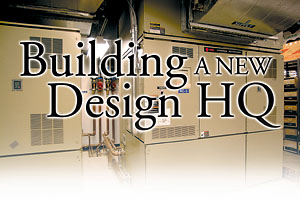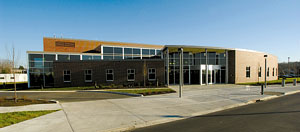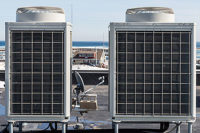
When the principals of Heapy Engineering LLC began looking for additional space for its expanding business needs, they decided to build not only a new office building, but to build a state-of-the-art facility that would be a working example of the mechanical and electrical systems that they include in their clients' designs.
Heapy Engineering is a mechanical and electrical consulting design firm based in Dayton, OH with a branch office in Columbus, OH and operations in Chicago. Heapy has been in business for 56 years primarily specializing in health care, criminal justice, telecommunications, commercial, and educational facility design. For Heapy, these areas have all experienced considerable growth over the years, and with the increasing demand from clients for commissioning services, they combined to fuel the growth that mandated the move to a larger space for the Dayton staff.
The former office site would not accommodate another building addition, despite the growing space needs. The building had been constructed in 1980 and was added to in 1985 and subsequently remodeled in 1995 to make more space available. Having completely outgrown the present site in only 20 years, the principals did not want this to occur with the new facility.
Therefore, in the future, should further space be required, (beyond the initial 45,000 sq ft), the new headquarters building has been designed to accommodate two 8,000-sq-ft building additions. General areas within the new building - restrooms, lunchroom, storage, etc. - were designed and constructed to accommodate these additional people loads.
User-Friendly, Energy- Efficient Design
The intent of the firm's principals was to provide an efficient and environmentally sustainable commercial building. A major focus of this intent was that the plumbing-hvac-electrical (PHE) systems in the building were to be designed for the employees to easily and readily, through a click of their computer mouse, control their office environment. The design team for this new, two-story headquarters building determined early on that incorporating a Web-based LonWorks system would be the cornerstone that satisfies this requirement.
System Integration
From the minute you access the building early in the morning, using your key fob to unlock the door, the building starts working automatically to meet your needs. The hvac system and lights in your work area come on, and even the path you take to your desk lights up. What brings these different hvac and electrical components together into a seamless system is LonWorks integration.Mechanical Systems of Dayton (MSD), the LonWorks system contractor that installed the system, worked closely with Heapy Engineering's project design engineers to integrate several different control manufacturers' equipment to operate as a single system. These hvac and electrical component controls each individually are state of the art in terms of energy-efficient operation. But what makes it truly unique is that their power is increased through the interaction made possible by the systems integration.
MSD's subcontractor, Commercial Control Services, provided the main system integration using a JACE-NP2 controller by Tridium. An occupancy sensor, for example, just does not turn off and on the lights, but, by day, changes the hvac control setpoints and, by night, becomes part of the security system. All made possible by using intelligent devices that speak the same language.
The LonWorks system controls, monitors, and adjusts space temperatures and provides access control, security, and lighting control system interfacing for each employee. In addition, it integrates energy-efficient features such as daylight harvesting, night setback, demand control, and occupancy monitoring for automatic control of the heating, cooling, and lighting systems in each individual office or zone.
MSD also coordinated the purchase of the LonWorks equipment from Johnson Controls, Belimo, Honeywell, Circon, Square D, and The Watt Stopper (for lighting controls), along with equipment from several other manufacturers that is monitored and controlled on the system.
Energy Considerations
Heapy's former office building received an ASHRAE International Energy Award for its unique design that utilized ground water-based heat pumps; a high-intensity indirect sodium lighting system in the design areas; and individual zone control for off-hours operation. This new building incorporates a similar philosophy of design by using the more stringent (and adopted as code in Ohio in January 2002) ASHRAE 90.1-1999 energy guidelines and the LEED energy guideline as standards to meet. Both of these go well beyond mandatory energy conservation codes and guidelines for building construction in Ohio.Energy conservation was performed in conjunction with other practices to benefit the employees and their environment. Building ventilation was designed based on ASHRAE 62-1999 requirements and continuous monitoring of air quality (CO2 monitoring) provides reduced ventilation rates when building occupancy is at minimum levels.
Additional energy efficienct construction methods were incorporated in this project. Some of these measures include: an energy-efficient, low-emission (low NOx) condensing boiler by Lochinvar Corporation; variable-speed drives (vsd's) on fans by Safetronics; high-performance low-E glazing windows; a daylight harvesting system by The Watt Stopper using Delta Power Supply light fixtures and dimming ballasts to maximize available daylight (which serves to lower electric lighting needs); and the use of added levels of insulation in the building envelope.
HVAC System
Maintaining a comfortable working environment during the heating season was an initial challenge for the hvac system designers. The engineer/CAD operator areas have 12-ft ceilings, and the 7,000-sq-ft glass atrium that houses the resource library, lunchroom, and reception areas has a 28-ft ceiling. This condition is compounded by the fact that much of the first-floor level is concrete slab on grade with the atrium nearly all hard-surface floor tile.This situation is further complicated with night-setback, wherein the building temperature is purposely allowed to drop during unoccupied hours to a preselected reduced setpoint to save energy. In addition, the extensive use of an open office concept, (i.e., cubicles), in the design area produces individual "pockets" of cold that are difficult to provide heating into from the ceiling level, greatly contributing to temperature stratification problems.
As was discovered in the previous Heapy building, the combination of these factors makes it difficult for the morning warm-up sequence of the hvac system to drive the space temperature evenly to the occupied setpoint. The resulting temperature stratification caused continual discomfort for the building occupants throughout the heating season.
To address the comfort issue of the high-bay areas, the overhead supply air system (consisting of four vertical, self-contained, water-cooled variable-air volume (vav) units by The Trane Company) is supplemented by a hot water radiant floor system manufactured by RTI Pex Piping Systems.
With operation of the Heapy building extending well beyond the normal 40-hr work week, individual zone control of building lighting and hvac systems is vital to adequately address energy conservation and operating cost issues. On the average, some portion of the staff (and not all the same from week to week) occupies the building approximately 100 hours every week.
Thirty-seven thermal zones were designed, separating individual design team areas, administrative areas, and atrium areas. This zoning provides maximum flexibility in the usage of the building by allowing the system to condition only specified occupied areas during nights and weekends.
Zone thermostats, connected to Johnson Control's Metasys Lon-based controllers, control vav reheat boxes (by Titus) that provide supply air, which is distributed to the spaces via ceiling diffusers. Local thermostats in areas where the radiant floor system exists also control the vav boxes serving the same area by sharing temperature information over the network to a Lon-based valve controller by Belimo. Individual employees can adjust the temperature in their zone through their computer terminal that is integrated with the Lon-based automatic temperature control network.
The high-efficiency hot water boiler that is used to provide heat into the vav heating loop also generates hot water for the radiant floor system. The Lochinvar Intellifin hot water boiler uses a Honeywell Lon-based controller that is directly integrated into the direct digital control system.
An outdoor cooling tower with an indoor sump provides heat rejection for the vertical self-contained a/c units. Cooling tower fans maintain condenser water temperature through the use of vsd's that modulate fan speed. This condenser water pumping system package, complete with variable-frequency drives, indoor sump, pumps, water treatment system, and a unit-mounted PC-based controller with LCD display was manufactured by Custom-Flo. The PC-based controller uses a LonTalk adaptor to communicate directly to the network via the Lon bus.
Regarding fire protection, the building is completely sprinklered. Recessed sprinkler heads are provided in all ceiling areas. All heads located in the exposed structural atrium area are sidewall type. The building was piped to provide a minimum amount of exposed piping in the atrium area.

Commissioning
The Heapy Engineering office building project has enjoyed a higher level of design and construction quality control than most building projects, partly because the owner was also the mechanical/electrical designer. More importantly though, as with any project, having been a part of a building commissioning process, typical PHE and building control systems "problems" were diagnosed and solved before the "owner" had to experience these issues.Heapy's commissioning department operates independent of, yet directly with, each of the design teams within the firm. They were handed this "challenge" of ensuring that the "owner" received a fully functioning building by the end of the project.
The building commissioning process is generally seen as the process of putting the building systems through their paces with a series of performance tests to ensure that all are working properly, but it can be much more than that.
Heapy Engineering has learned over the years that it takes quality assurances at all stages of a design and construction project to end up with smooth-running building system that perform to the owner's expectations upon completion. Further complicating the traditional PHE design for a building by incorporating a LonWorks system with multiple vendors into the design certainly requires good communication and coordination at all phases of the design and construction process.
The first step in the building commissioning process is to meet with the owner and design team to verify and confirm that the facility owner's expectations will be met by the resulting design. This confirmation is a process that involves continuously reviewing with the owner and documenting that their expectations are met throughout the entire design and construction process.
As part of the construction process, Heapy Engineering's field observation department monitored the progress and quality of the project. The firm's commissioning department provided additional quality control, such as reviewing project submittals, along with the design team, to ensure constructability of the equipment selected. Also, the commissioning department met and worked with contractors on site to ensure the method of installation met design requirements.
Documentation of the quality assurances that took place during the construction phase included: start-up reports, prefunctional checklists, and system test reports.
At the end of the construction phase the commissioning team began the acceptance phase of the project. During this acceptance phase, each building system was put through a series of functional and performance tests that were designed to verify proper operation through all possible conditions. All of the test results were documented and deficiencies noted for correction by the contractor.
For instance, when it was discovered that water flow in the condenser water system was not meeting specified values, the commissioning process discovered that a worker's glove had somehow ended up under the strainer basket.
After completion of the acceptance phase, the commissioning team will spend the next year, while the building is under contract warranty, monitoring system operation. Monitoring will include periodic updates with the facility owner to obtain feedback regarding building operation and watching system operation directly, such as through the building's Lon-based hvac temperature control system. The Web access makes monitoring extremely flexible for the installing contractors as well as for the commissioning team as they verify that all systems are running smoothly.
Conclusion
This building proves that with proper planning for functionality of the space and the systems that serve it and implementing a commissioning process to ensure the planning was properly implemented - a successful and fully integrated LonWorks system is not just the wave of the future but is already functionally available for building owners/users.ESSupporting Cast
- Heapy Engineering, LLC - Mechanical/Electrical design
- City of Kettering - Developer
- Ruetschle Architects - Architect
- Miller Valentine Group - General contractor
- LJB - Civil/Structural design
- Mechanical Systems of Dayton - ATC contractor
- Applied Mechanical Systems - Plumbing/Hvac contractor
- Wagner Smith - Electrical contractor
- A-1 Sprinkler Co. - Fire protection contractor
- Jacobs Telephone Contractors - Structured cabling



